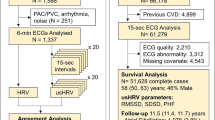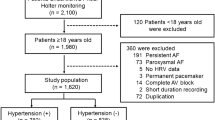Abstract
Although autonomic disturbances are known to precede hypertension onset, the risks underlying different ranges of blood pressure and impaired cardiac autonomic modulation are still unknown. This study aimed to identify the risk of hypertension incidence related to low heart-rate variability profile in normotensive blood pressure subcategories: normal (<120/80 mmHg) and prehypertension (120/80–139/89 mmHg) in a 4-year follow-up. 7665 participants free of hypertension at baseline were examined. They were allocated into one of two groups (<P25 and ≥P25) based on age-specific value distributions of heart-rate variability ranges presented in the literature. The relationship between heart-rate variability parameters (SDNN, RMSSD, VLF, LF, and HF) and hypertension incidence was analyzed using Poisson regression. The reference for the independent variable in these regressions was the dataset with all HRV values ≥P25. After full adjustments for age, sex, ethnicity, educational level, body mass index, smoking status, glucose, insulin, dyslipidemia, alcohol consumption, and physical activity, low values for all heart-rate variability indices were significantly associated with an increased relative risk of developing hypertension in the overall sample. Individuals with normal BP levels presented an increased risk for low SDNN, VLF, and LF values, whereas the risk in prehypertensive participants was only verified for low VLF. In conclusion, cardio autonomic disturbances precede the incidence of clinical hypertension and are potentially involved in its pathophysiological basis and progression. Even individuals with normal blood pressure may be at an increased risk for future hypertension in the presence of reduced cardio autonomic control.
This is a preview of subscription content, access via your institution
Access options
Subscribe to this journal
Receive 12 digital issues and online access to articles
$119.00 per year
only $9.92 per issue
Buy this article
- Purchase on Springer Link
- Instant access to full article PDF
Prices may be subject to local taxes which are calculated during checkout



Similar content being viewed by others
References
Kanegae H, Oikawa T, Kario K. Should pre-hypertension be treated? Curr Hypertens Rep. 2017;19:1–9.
Chen Q, Yin YJ, Chen WY, Wu JN, Huang X. Assessment of the association between serum uric acid levels and the incidence of hypertension in nonmetabolic syndrome subjects. Medicine. 2018;97:e9765.
Thayer JF, Yamamoto SS, Brosschot JF. The relationship of autonomic imbalance, heart rate variability and cardiovascular disease risk factors. Int J Cardiol. 2010;141:122–31.
Singh JP, Larson MG, Tsuji H, Evans JC, Donnell CJO, Levy D. Reduced heart rate variability and insights into pathogenesis of hypertension: the Framingham Heart Study. Hypertension. 1998;32:293–7.
Jae SY, Bunsawat K, Fadel PJ, Fernhall B, Choi YH, Park JB, et al. Attenuated heart rate recovery after exercise testing and risk of incident hypertension in men. Am J Hypertens. 2016;29:1103–8.
Grassi G, Mark A, Esler M. The sympathetic nervous system alterations in human hypertension. Circ Res. 2015;116:976–90.
Schroeder EB, Liao D, Chambless LE, Prineas RJ, Evans GW, Heiss G. Hypertension, blood pressure, and heart rate variability: the Atherosclerosis Risk in Communities (ARIC) Study. Hypertension. 2003;42:1106–11.
Task Force of the European Society of Cardiology the North American Society of Pacing Electrophysiology. Heart rate variability: standards of measurement, physiological interpretation, and clinical use. Circulation. 1996;93:1043–65.
Hoshi RA, Vanderlei L, Godoy MF, Bastos FN, Netto J Jr, Pastre CM. Temporal sequence of recovery-related events following maximal exercise assessed by heart rate variability and blood lactate concentration. Clin Physiol Funct Imaging. 2017;37:536–43.
Hoshi RA, Pastre CM, Vanderlei LCM, Godoy MF. Poincaré plot indexes of heart rate variability: relationships with other nonlinear variables. Auton Neurosci Basic Clin. 2013;177. https://doi.org/10.1016/j.autneu.2013.05.004.
Vanderlei LCM, Pastre CM, Hoshi RA, de Carvalho TD, de Godoy MF. Basic notions of heart rate variability and its clinical applicability. Braz J Cardiovasc Surg. 2009;24:205–17.
Shaffer F, McCraty R, Zerr CL. A healthy heart is not a metronome: an integrative review of the heart’s anatomy and heart rate variability. Front Psychol. 2014;5:1040.
Hoshi RA, Santos IS, Dantas EM, Andreão RV, Schmidt MI, Duncan BB, et al. Decreased heart rate variability as a predictor for diabetes—a Prospective Study of the Brazilian Longitudinal Study of Adult Health. Diabetes Metab Res Rev. 2019;35:e3175.
Liao D, Cai J, Barnes RW, Tyroler HA, Rautaharju P, Hohne I, et al. Association of cardiac autonomic function and the development of hypertension—the ARIC Study. Am J Hypertens. 1996;7061:1147–56.
Joint National Committee. The Seventh Report of the Joint National Committee on Complete Report on Prevention, Detection, Evaluation, and Treatment of High Blood Pressure. 2004. https://www.nhlbi.nih.gov/files/docs/guidelines/jnc7full.pdf.
Doğru MT, Simşek V, Sahin O, Ozer N. Differences in autonomic activity in individuals with optimal, normal, and high-normal blood pressure levels. Turk Kardiyol Dern Ars. 2010;38:182–8.
Lucini D, Mela GS, Malliani A, Pagani M. Impairment in cardiac autonomic regulation preceding arterial hypertension in humans. Circulation. 2002;106:2673–9.
Aquino EML, Barreto SM, Bensenor IM, Carvalho MS, Chor D, Duncan BB, et al. Brazilian longitudinal study of adult health (ELSA-Brasil): objectives and design. Am J Epidemiol. 2012;175:315–24.
Mill JG, Pinto K, Griep RH, Goulart A, Foppa M, Lotufo P, et al. Medical assessments and measurements in ELSA-Brasil. Rev Saude Publica. 2013;47:54–62.
Williams B, Mancia G, Spiering W, Agabiti RE, Azizi M, Burnier M, et al. 2018 ESC/ESH guidelines for the management of arterial hypertension. Eur Heart J. 2018;39:3021–104.
Schmidt M, Hoffmann JF, Diniz MF, Lotufo PA, Griep RH, Bensenor IM et al. High prevalence of diabetes and intermediate hyperglycemia—the Brazilian Longitudinal Study of Adult Health (ELSA-Brasil). Diabetol Metab Syndr. 2014;6. https://doi.org/10.1186/1758-5996-6-123.
Bensenor IM, Griep RH, Pinto KA, Faria CP, de, Felisbino-Mendes M, Caetano EI, et al. Routines of organization of clinical tests and interviews in the ELSA-Brasil investigation center. Rev Saude Publica. 2013;47:37–47.
Tomiyama H, Kimura Y, Sakuma Y, Shiojima K, Yamamoto A, Saito I, et al. Effects of an ACE Inhibitor and a calcium channel blocker on cardiovascular autonomic nervous system and carotid distensibility in patients with mild to moderate hypertension. Am J Hypertens. 1998;11:682–9.
Pinar E, García-Alberola A, Llamas C, Vicente T, López-Candel J, Rojo JL, et al. Effects of verapamil on indexes of heart rate variability after acute myocardial infarction. Am J Cardiol. 1998;81:1085–9.
Brembilla-Perrot B, Jacquemin L, Beurrier D. Relationships between heart rate variability and antiarrhythmic effects of hydroquinidine. Cardiovasc drugs Ther. 1997;11. https://doi.org/10.1023/A:1007709808576.
Dantas EM, Kemp AH, Andreão RV, da Silva VJD, Brunoni AR, Hoshi RA, et al. Reference values for short-term resting-state heart rate variability in healthy adults: results from the Brazilian Longitudinal Study of Adult Health-ELSA-Brasil study. Psychophysiology. 2018;55:e13052.
Chor D, Luiz Pinho Ribeiro A, Sá Carvalho M, Bartholow Duncan B, Andrade Lotufo P, Araújo, Nobre A, et al. Prevalence, awareness, treatment and influence of socioeconomic variables on control of high blood pressure: results of the ELSA-Brasil Study. PLoS ONE. 2015;10:e0127382.
Matsudo S, Araújo T, Matsudo V, Andrade D, Andrade E, Oliveira LC, et al. Questionário Internacional de Atividade Física (IPAQ): Estudo de validade e reprodutibilidade no Brasil. Ativ FíSci e Saúde. 2001;6:5–18.
World Health Organization. Global recommendations on physical activity for health. Geneva; World Health Organization: 2010.
Verma N. Sympathetic nervous system and hypertension. Hypertens J. 2017;3:27–36.
Selby J, Friedman G, Quesenberry C. Precursors of essential hypertension: pulmonary function, heart rate, uric acid, serum cholesterol, and other serum chemistries. Am J Epidemiol. 1990;131:1017–27.
Palatini P, Julius S. Heart rate and the cardiovascular risk. J Hypertens. 1997;15:3–17.
McCraty R, Shaffer F. Heart rate variability: new perspectives on physiological mechanisms, assessment of self-regulatory capacity, and health risk. Glob Adv Heal Med. 2015;4. https://doi.org/10.7453/gahmj.2014.073.
Lampert R, Bremner J, Su S, Miller A, Lee F, Cheema F, et al. Decreased heart rate variability is associated with higher levels of inflammation in middle-aged men. Am Heart J. 2008;156:759.e1–7.
Virtanen R, Jula A, Kuusela T, Helenius H, Voipio-Pulkki LM. Reduced heart rate variability in hypertension: Associations with lifestyle factors and plasma renin activity. J Hum Hypertens. 2003;17:171–8.
Shaffer F, Ginsberg JP. An overview of heart rate variability metrics and norms. Front Public Health. 2017;5:1–17.
Reyes del Paso GA, Langewitz W, Mulder LJM, van Roon A, Duschek S. The utility of low frequency heart rate variability as an index of sympathetic cardiac tone: a review with emphasis on a reanalysis of previous studies. Psychophysiology. 2013;50:477–87.
Hoshi RA, Santos IS, Dantas EM, Andreão RV, Mill JG, Duncan BB, et al. Diabetes and subclinical hypothyroidism on heart rate variability. Eur J Clin Invest. 2020;50:e13349.
Acknowledgements
We are very grateful to all the ELSA-Brasil participants and research staff.
Funding
This study was funded by the Brazilian Ministry of Health (Science and Technology Department) and Brazilian Ministry of Science and Technology (FINEP and CNPq).
Author information
Authors and Affiliations
Corresponding author
Ethics declarations
Conflict of interest
The authors declare that they have no conflict of interest.
Additional information
Publisher’s note Springer Nature remains neutral with regard to jurisdictional claims in published maps and institutional affiliations.
Supplementary information
Rights and permissions
About this article
Cite this article
Hoshi, R.A., Santos, I.S., Dantas, E.M. et al. Reduced heart-rate variability and increased risk of hypertension—a prospective study of the ELSA-Brasil. J Hum Hypertens 35, 1088–1097 (2021). https://doi.org/10.1038/s41371-020-00460-w
Received:
Revised:
Accepted:
Published:
Issue Date:
DOI: https://doi.org/10.1038/s41371-020-00460-w
This article is cited by
-
Association of Sports Practice in Childhood and Adolescence with Cardiac Autonomic Modulation in Adulthood: A Retrospective Epidemiological Study
Sports Medicine - Open (2024)
-
Association of Early Sports Practice with Cardiovascular Risk Factors in Community-Dwelling Adults: A Retrospective Epidemiological Study
Sports Medicine - Open (2023)



